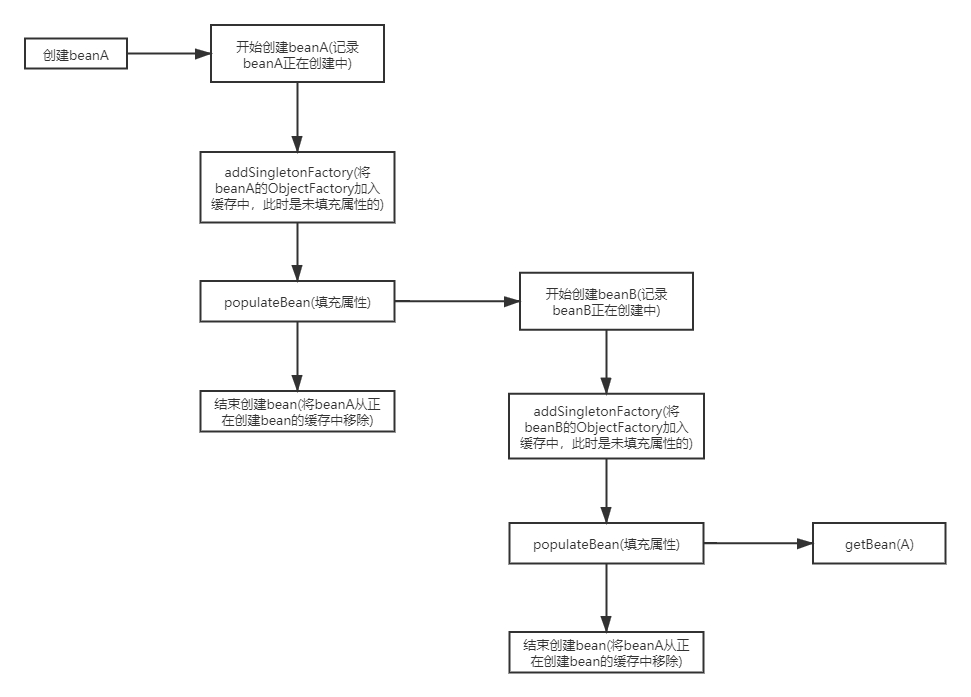Spring IoC 循环依赖的处理
前言
本系列全部基于 Spring 5.2.2.BUILD-SNAPSHOT 版本。因为 Spring 整个体系太过于庞大,所以只会进行关键部分的源码解析。
本篇文章主要介绍 Spring IoC 是怎么解决循环依赖的问题的。
正文
什么是循环依赖
循环依赖就是循环引用,就是两个或多个 bean 相互之间的持有对方,比如A引用B,B引用A,像下面伪代码所示:
public class A {
private B b;
// 省略get和set方法...
}
public class B {
private A a;
// 省略get和set方法...
}
Spring 如何解决循环依赖
Spring IoC 容器对循环依赖的处理有三种情况:
BeanCurrentlylnCreationException setter BeanCurrentlylnCreationException
构造器循环依赖
还是假设上面的A和B类是构造器循环依赖,如下所示:
public class A {
private B b;
public A(B b) {
this.b = b;
}
// 省略get和set方法...
}
public class B {
private A a;
public B(A a) {
this.a = a;
}
// 省略get和set方法...
}
然后我们在 XML 中配置了构造器自动注入,如下:
<?xml version="1.0" encoding="UTF-8"?>
<beans xmlns="http://www.springframework.org/schema/beans"
xmlns:xsi="http://www.w3.org/2001/XMLSchema-instance"
xsi:schemaLocation="http://www.springframework.org/schema/beans http://www.springframework.org/schema/beans/spring-beans.xsd">
<bean id="a" class="com.leisurexi.ioc.circular.reference.A" autowire="constructor" />
<bean id="b" class="com.leisurexi.ioc.circular.reference.B" autowire="constructor" />
</beans>
那么我们在获取 A 时,首先会进入 doGetBean() 方法(该方法在 Spring IoC bean 的加载 中分析过),会进行到如下代码块:
protected <T> T doGetBean(final String name, @Nullable final Class<T> requiredType, @Nullable final Object[] args, boolean typeCheckOnly) throws BeansException {
// 省略其它代码...
// 如果 bean 的作用域是单例
if (mbd.isSingleton()) {
// 创建和注册单例 bean
sharedInstance = getSingleton(beanName, () -> {
try {
// 创建 bean 实例
return createBean(beanName, mbd, args);
}
catch (BeansException ex) {
destroySingleton(beanName);
throw ex;
}
});
// 获取bean实例
bean = getObjectForBeanInstance(sharedInstance, name, beanName, mbd);
}
// 省略其它代码...
}
上面方法中的 getSingleton() 方法会判断是否是第一次创建该 bean ,如果是第一次会先去创建 bean ,也就是调用 ObjectFacoty 的 getObject() 方法,即调用 createBean() 方法创建 bean 前,会先将当前正要创建的 bean 记录在缓存 singletonsCurrentlyInCreation 中。
在创建A时发现依赖 B,便先去创建 B;B在创建时发现依赖A,此时A因为是通过构造函数创建,所以没创建完,便又去创建A,发现A存在于 singletonsCurrentlyInCreation ,即正在创建中,便抛出 BeanCurrentlylnCreationException 异常。
public Object getSingleton(String beanName, ObjectFactory<?> singletonFactory) {
Assert.notNull(beanName, "Bean name must not be null");
// 加锁
synchronized (this.singletonObjects) {
Object singletonObject = this.singletonObjects.get(beanName);
// 一级缓存中不存在当前 bean,也就是当前 bean 第一次创建
if (singletonObject == null) {
// 如果当前正在销毁 singletons,抛出异常
if (this.singletonsCurrentlyInDestruction) {
throw new BeanCreationNotAllowedException(beanName, "Singleton bean creation not allowed while singletons of this factory are in destruction (Do not request a bean from a BeanFactory in a destroy method implementation!)");
}
// 创建单例 bean 之前的回调
beforeSingletonCreation(beanName);
boolean newSingleton = false;
boolean recordSuppressedExceptions = (this.suppressedExceptions == null);
if (recordSuppressedExceptions) {
this.suppressedExceptions = new LinkedHashSet<>();
}
try {
// 获取 bean 实例
singletonObject = singletonFactory.getObject();
newSingleton = true;
}
// 省略异常处理...
finally {
if (recordSuppressedExceptions) {
this.suppressedExceptions = null;
}
// 创建单例 bean 之后的回调
afterSingletonCreation(beanName);
}
if (newSingleton) {
// 将 singletonObject 放入一级缓存,并从二级和三级缓存中移除
addSingleton(beanName, singletonObject);
}
}
// 返回 bean 实例
return singletonObject;
}
}
// 单例 bean 创建前的回调方法,默认实现是将 beanName 加入到当前正在创建 bean 的缓存中,
// 这样便可以对循环依赖进行检测
protected void beforeSingletonCreation(String beanName) {
if (!this.inCreationCheckExclusions.contains(beanName) && !this.singletonsCurrentlyInCreation.add(beanName)) {
throw new BeanCurrentlyInCreationException(beanName);
}
}
// 单例 bean 创建后的回调方法,默认实现是将 beanName 从当前正在创建 bean 的缓存中移除
protected void afterSingletonCreation(String beanName) {
if (!this.inCreationCheckExclusions.contains(beanName) && !this.singletonsCurrentlyInCreation.remove(beanName)) {
throw new IllegalStateException("Singleton '" + beanName + "' isn't currently in creation");
}
}
protected void addSingleton(String beanName, Object singletonObject) {
synchronized (this.singletonObjects) {
// 这边bean已经初始化完成了,放入一级缓存
this.singletonObjects.put(beanName, singletonObject);
// 移除三级缓存
this.singletonFactories.remove(beanName);
// 移除二级缓存
this.earlySingletonObjects.remove(beanName);
// 将 beanName 添加到已注册 bean 缓存中
this.registeredSingletons.add(beanName);
}
}
setter循环依赖
还是假设上面的A和B类是 field 属性依赖注入循环依赖,如下所示:
public class A {
private B b;
// 省略get和set方法...
}
public class B {
private A a;
// 省略get和set方法...
}
然后我们在 XML 中配置了按照类型自动注入,如下:
<?xml version="1.0" encoding="UTF-8"?>
<beans xmlns="http://www.springframework.org/schema/beans"
xmlns:xsi="http://www.w3.org/2001/XMLSchema-instance"
xsi:schemaLocation="http://www.springframework.org/schema/beans http://www.springframework.org/schema/beans/spring-beans.xsd">
<bean id="a" class="com.leisurexi.ioc.circular.reference.A" autowire="byType" />
<bean id="b" class="com.leisurexi.ioc.circular.reference.B" autowire="byType" />
</beans>
Spring 在解决单例循环依赖时引入了三级缓存,如下所示:
// 一级缓存,存储已经初始化完成的bean private final Map<String, Object> singletonObjects = new ConcurrentHashMap<>(256); // 二级缓存,存储已经实例化完成的bean private final Map<String, Object> earlySingletonObjects = new HashMap<>(16); // 三级缓存,存储创建bean实例的ObjectFactory private final Map<String, ObjectFactory<?>> singletonFactories = new HashMap<>(16); // 按先后顺序记录已经注册的单例bean private final Set<String> registeredSingletons = new LinkedHashSet<>(256);
首先在创建A时,会进入到 doCreateBean() 方法(前面的流程可以查看 Spring IoC bean 的创建 一文),如下:
protected Object doCreateBean(final String beanName, final RootBeanDefinition mbd, final @Nullable Object[] args) throws BeanCreationException {
// 获取bean的实例
BeanWrapper instanceWrapper = null;
if (instanceWrapper == null) {
// 通过构造函数反射创建bean的实例,但是属性并未赋值
instanceWrapper = createBeanInstance(beanName, mbd, args);
}
// 获取bean的实例
final Object bean = instanceWrapper.getWrappedInstance();
// 省略其它代码...
// bean的作用域是单例 && 允许循环引用 && 当前bean正在创建中
boolean earlySingletonExposure = (mbd.isSingleton() && this.allowCircularReferences && isSingletonCurrentlyInCreation(beanName));
// 如果允许bean提前曝光
if (earlySingletonExposure) {
// 将beanName和ObjectFactory形成的key-value对放入singletonFactories缓存中
addSingletonFactory(beanName, () -> getEarlyBeanReference(beanName, mbd, bean));
}
// 省略其它代码...
}
在调用 addSingletonFactory() 方法前A的实例已经创建出来了,只是还未进行属性赋值和初始化阶段,接下来将它放入了三级缓存中,如下:
protected void addSingletonFactory(String beanName, ObjectFactory<?> singletonFactory) {
Assert.notNull(singletonFactory, "Singleton factory must not be null");
// 加锁
synchronized (this.singletonObjects) {
// 如果一级缓存中不包含当前bean
if (!this.singletonObjects.containsKey(beanName)) {
// 将ObjectFactory放入三级缓存
this.singletonFactories.put(beanName, singletonFactory);
// 从二级缓存中移除
this.earlySingletonObjects.remove(beanName);
// 将beanName加入到已经注册过的单例bean缓存中
this.registeredSingletons.add(beanName);
}
}
}
接下来A进行属性赋值阶段(会在后续文章中单独分析这个阶段),发现依赖B,便去获取B,发现B还没有被创建,所以走创建流程;在B进入属性赋值阶段时发现依赖A,就去调用 getBean() 方法获取A,此时会进入 getSingleton() 方法(该方法的调用流程在 Spring IoC bean 的加载 一文中分析过),如下:
public Object getSingleton(String beanName) {
// allowEarlyReference设置为true表示允许早期依赖
return getSingleton(beanName, true);
}
protected Object getSingleton(String beanName, boolean allowEarlyReference) {
// 先从一级缓存中,检查单例缓存是否存在
Object singletonObject = this.singletonObjects.get(beanName);
// 如果为空,并且当前bean正在创建中,锁定全局变量进行处理
if (singletonObject == null && isSingletonCurrentlyInCreation(beanName)) {
synchronized (this.singletonObjects) {
// 从二级缓存中获取
singletonObject = this.earlySingletonObjects.get(beanName);
// 二级缓存为空 && bean允许提前曝光
if (singletonObject == null && allowEarlyReference) {
// 从三级缓存中获取bean对应的ObjectFactory
ObjectFactory<?> singletonFactory = this.singletonFactories.get(beanName);
if (singletonFactory != null) {
// 调用预先设定的getObject(),获取bean实例
singletonObject = singletonFactory.getObject();
// 放入到二级缓存中,并从三级缓存中删除
// 这时bean已经实例化完但还未初始化完
// 在该bean未初始化完时如果有别的bean引用该bean,可以直接从二级缓存中取出返回
this.earlySingletonObjects.put(beanName, singletonObject);
this.singletonFactories.remove(beanName);
}
}
}
}
return singletonObject;
}
尝试一级缓存 singletonObjects (肯定没有,因为A还没初始化完全),尝试二级缓存 earlySingletonObjects (也没有),尝试三级缓存 singletonFactories ,由于A通过 ObjectFactory 将自己提前曝光了,所以B能够通过 ObjectFactory.getObject() 拿到A对象(虽然A还没有初始化完全,但是总比没有好呀)。B拿到A后顺利创建并初始化完成,调用上面分析过的 addSingleton() 方法将自己放入一级缓存中。此时返回A中,A也能顺利拿到完全初始化的B进行后续的阶段,最后也将自己放入一级缓存中,并从二级和三级缓存中移除。
过程图如下所示:

非单例循环依赖
对于非单例的 bean ,Spring 容器无法完成依赖注入,因为 Spring 容器不进行缓存,因此无法提前暴露一个创建中的 bean 。
总结
本文主要介绍了 Spring 对三种循环依赖的处理,其实还有一种字段循环依赖,比如 @Autowired 注解标注的字段,但它和 setter 循环依赖的解决方法一样,这里就没有多说。
最后,我模仿 Spring 写了一个精简版,代码会持续更新。地址: https://github.com/leisurexi/tiny-spring 。
参考
- 《Spring 源码深度解析》—— 郝佳
- https://juejin.im/post/5c98a7b4f265da60ee12e9b2
- 本文标签: src IO git App final BeanDefinition spring ConcurrentHashMap 配置 XML build 一级缓存 struct CTO 锁 文章 HashMap map 实例 schema 二级缓存 HashSet 代码 解决方法 删除 id cat 解析 spring ioc ioc 源码 缓存 GitHub value http MQ https HTML 总结 bean root synchronized UI key
- 版权声明: 本文为互联网转载文章,出处已在文章中说明(部分除外)。如果侵权,请联系本站长删除,谢谢。
- 本文海报: 生成海报一 生成海报二











![[HBLOG]公众号](https://www.liuhaihua.cn/img/qrcode_gzh.jpg)

